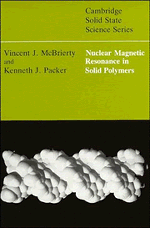Book contents
- Frontmatter
- Contents
- Preface
- Acknowledgements
- Glossary of terms
- 1 The NMR of solid polymers: an overview
- 2 Basic concepts in NMR
- 3 Nuclear spin interactions
- 4 Experimental methods
- 5 Structure and motion in solid polymers
- 6 Structural heterogeneity in polymers
- 7 Oriented polymers
- 8 Selected topics
- Appendix 1 Data on common polymers
- Appendix 2 The rotation operator
- Appendix 3 Rotation of tensors between coordinate frames
- Appendix 4 Spatial distribution of structural units in a polymer
- Appendix 5 The internal Hamiltonian
- Appendix 6 Spectral lineshapes
- Appendix 7 Analysis of spinning sidebands
- Bibliography
- References
- Author index
- Subject index
5 - Structure and motion in solid polymers
Published online by Cambridge University Press: 19 October 2009
- Frontmatter
- Contents
- Preface
- Acknowledgements
- Glossary of terms
- 1 The NMR of solid polymers: an overview
- 2 Basic concepts in NMR
- 3 Nuclear spin interactions
- 4 Experimental methods
- 5 Structure and motion in solid polymers
- 6 Structural heterogeneity in polymers
- 7 Oriented polymers
- 8 Selected topics
- Appendix 1 Data on common polymers
- Appendix 2 The rotation operator
- Appendix 3 Rotation of tensors between coordinate frames
- Appendix 4 Spatial distribution of structural units in a polymer
- Appendix 5 The internal Hamiltonian
- Appendix 6 Spectral lineshapes
- Appendix 7 Analysis of spinning sidebands
- Bibliography
- References
- Author index
- Subject index
Summary
Introduction
Application of NMR principles and experiments to solid polymers described thus far will now be illustrated in this and subsequent chapters. It is not intended to present comprehensive reviews since these appear in the literature on a regular basis and will be referred to as appropriate. Rather, the intention is to cover the main features of the role of NMR in illuminating relevant polymer properties in order to give the reader a clear view of the possibilities and diversity of options. The choices of how to organise the presentation of information are many. Here the interests of the polymer scientist rather than of the NMR specialist are emphasised.
These interests will vary considerably. Those who primarily wish to synthesise new polymers will want to know what polymer has been made, largely in terms of its chemistry. Those more interested in polymer properties and processing will want to use NMR to develop further their understanding of the relationship of mechanical and other properties to chain organisation, orientation, dynamics and so on. NMR of polymer solutions and melts has been of great utility, particularly since the introduction of pulsed Fourier transform methods and the routine availability of high-resolution 13C spectra. Such liquid-state high-resolution spectra have given the synthetic polymer chemist greater insight into the effects of synthesis conditions on microstructure, molecular weight distributions and so forth.
- Type
- Chapter
- Information
- Nuclear Magnetic Resonance in Solid Polymers , pp. 124 - 190Publisher: Cambridge University PressPrint publication year: 1993



